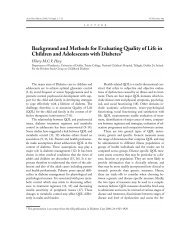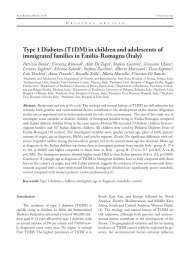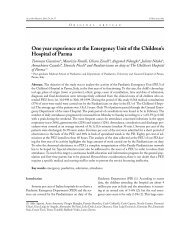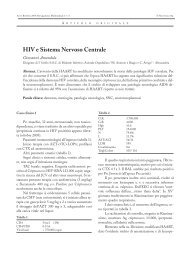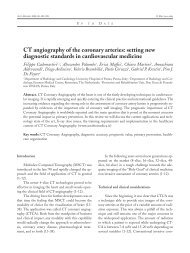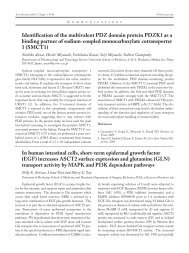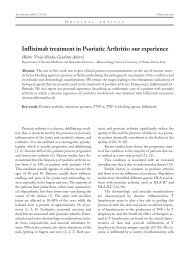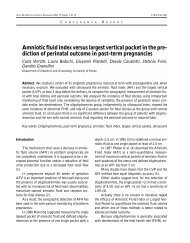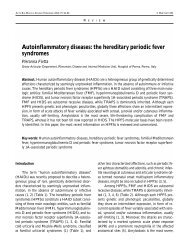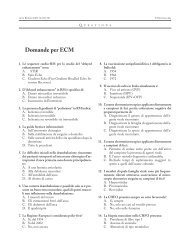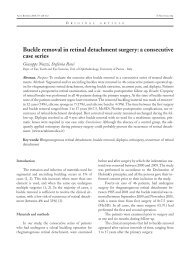Short reports+frontesp96-98 - Acta Bio Medica Atenei Parmensis
Short reports+frontesp96-98 - Acta Bio Medica Atenei Parmensis
Short reports+frontesp96-98 - Acta Bio Medica Atenei Parmensis
Create successful ePaper yourself
Turn your PDF publications into a flip-book with our unique Google optimized e-Paper software.
110 <strong>Short</strong> Reports<br />
3. Lagios MD. DCIS: current concepts in diagnosis and management.<br />
Breast J 2003; 9: 22-4.<br />
4. Bleicher RJ, Giuliano AE. The selective use of sentinel node<br />
biopsy in ductal carcinoma in situ. Arch Surg 2003; 138: 489.<br />
5. Intra M, Veronesi P, Mazzarol G, et al. Axillary sentinel<br />
lymph node biopsy in patients with pure ductal carcinoma in<br />
situ of the breast. Arch Surg 2003; 138: 309-13.<br />
Obstructive jaundice in elderly patients<br />
F. Iovino, R. Ruggiero, F. Freda, E. Irlandese, S. Gili, F.<br />
Lo Schiavo<br />
Oncology Department of General and Specialistic Surgery, III<br />
Division of General and Oncological Surgery, II University of<br />
Naples, Naples, Italy<br />
Background: In elderly patients the obstruction of<br />
the biliary ducts can be determined by benign or malign<br />
diseases. Usually metabolic disorders and cardiovascular<br />
diseases are present in this age and diagnosis and<br />
treatment are of major difficulties. Aim: To evaluate if<br />
diagnostic procedures and therapeutic choices of the<br />
obstructive jaundice in elderly patients are modified by<br />
clinical and laboratory parameters. Patients and methods:<br />
From January 2003 to March 2005 were studied 10 elderly<br />
patients with obstructive jaundice (5 female; 5<br />
male). The mean age was 72 years old (65-91). The<br />
cause of the bile duct obstruction was benign disease<br />
(choledocholithiasis) in 6 of patients and malignant disease<br />
in 4 (carcinoma of gallbladder in 2, hilar biliary<br />
carcinoma in 1, carcinoma of ampulla Vater in 1). In 5<br />
of patients cholangitis was associated. In all patients clinical<br />
and laboratory parameters was investigated. Magnetic<br />
resonance cholangiopancreatography (MRCP)<br />
and endoscopic retrograde cholangiopancreatography<br />
(ERCP) were performed. Results: In all cases ERCP<br />
confirmed the diagnosis of MRCP. The treatment of<br />
choice in all cases was endoscopic. Biliary obstruction<br />
for choledocholitiasis was normalized after ERCP for<br />
spontaneous migration of stones and stones fragments<br />
cleared from the duct without procedure – related complication.<br />
Cholecystectomy was performed afterwards.<br />
In patients with malignant disease was inserted endoscopic<br />
stent by ERCP in 3 of the patients and by PTC<br />
in 1 patient. The jaundice was alleviated in all cases. No<br />
death was correlated and median survival of the patients<br />
treated to endoscopic stent was 11 months. Conclusions:<br />
In elderly patients the diagnosis of level and<br />
cause of obstruction can be performed by MRCP with<br />
elevated accuracy. The treatment of choice for choledocholitiasis<br />
is endoscopic so as in young patients. For<br />
malignant strictures endoscopic insertion of stents by<br />
ERCP or PTC is gold standard when by-pass surgery<br />
or tumour resection cannot be performed for morbidity<br />
associated. We believe that endoscopic palliation is a safe<br />
choice for the quality of life as metabolic disorders<br />
and cardiovascular disease may interfere with a more<br />
aggressive decision. Moreover metabolic disorders and<br />
cardiovascular disease have not modified diagnostic<br />
procedures and choice of treatment in this study.<br />
The role of sentinel node biopsy in ductal<br />
carcinoma in situ (DCIS) of the breast: why map<br />
DCIS?<br />
M. Lamberti, D.P. Calabrese, G. Di Martino, A. Farina,<br />
M. Lamberti, E. Palma, G. Limite<br />
Department of General, Oncological and Videoassisted Surgery,<br />
University of Naples Federico II, Naples, Italy<br />
DCIS of the breast is a heterogeneous group of<br />
lesions with diverse clinical presentation, histologic<br />
features, and malignant potential. The current treatment<br />
of DCIS is breast conservation plus radiation<br />
therapy, mastectomy for diffuse lesions, no axilla. An<br />
axillary dissection is not required, low incidence of nodal<br />
metastasis < 2% and significant morbility. The role<br />
of sentinel biopsy in DCIS is controversial. We<br />
perform sentinel node biopsy when DCIS patients:<br />
• palpable or large mammographic mass;<br />
• DCIS requiring mastectomy;<br />
• previous biopsy in which the pathologist “cannot<br />
rule out invasion”.<br />
Survival and recurrence after surgery for<br />
periampullary tumors<br />
P. Limongelli 1 , M. Di Martino 1 , V. Maffettone 1 , G.W.<br />
Stamp 2 , N.A. Habib 2 , R.C.N. Williamson 2 , L.R. Jiao 2<br />
1<br />
I Division of General and Gastroenterologic Surgery, II University<br />
of Naples, Naples, Italy; 2 HPB Unit, Hammersmith<br />
Campus, Hammersmith Hospital, Division of Surgery and Intensive<br />
Care, Imperial College School of Medicine, Du Cane<br />
Road, London, UK



